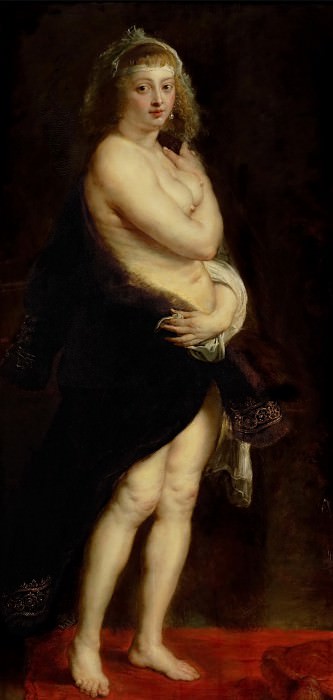The Fur Coat Peter Paul Rubens (1577-1640)
Peter Paul Rubens – The Fur Coat
Edit attribution
Image taken from other album: gallerix.org/s/1560281550/N/1805117182/
Download full size: 2880×6070 px (5,8 Mb)
Painter: Peter Paul Rubens
After the death of his first wife in 1626, Rubens marries a second time, his wife becoming the daughter of his friend, the young Helena Faurment, with whom he lived the happy 10 years of his life until his death. During this period, she very often posed for portraits of her husband, helping to create the world’s masterpieces with her participation. Particularly notable among these is the painting The Coat, which depicts the frank, sensual and full of captivating beauty image of the great Flemish painter’s second wife.
Description of Peter Rubens’s painting The Coat
After the death of his first wife in 1626, Rubens marries a second time, his wife becoming the daughter of his friend, the young Helena Faurment, with whom he lived the happy 10 years of his life until his death. During this period, she very often posed for portraits of her husband, helping to create the world’s masterpieces with her participation.
Particularly notable among these is the painting The Coat, which depicts the frank, sensual and full of captivating beauty image of the great Flemish painter’s second wife. Rubens’ portrait of The Coat also has another title, Venus in Furs. And indeed, Helena in the picture represents youth and beauty. The woman is full of freshness, femininity and charm, and her elastic body is covered by a velvet coat, elegantly thrown over her shoulders.
In this painting the technique of the late Rubens reaches the highest degree of refinement. He has a fine sense of tone: the body of the lushly-breasted beauty is overflowing with delicate shades of pearl, which is delicately set off by the dark background - the fur coat.
There are no parallel lines in the picture, they are all broken. Her arms, calves of legs, neck and soft, airy hair - the whole body is gently immersed in the fur, while retreating into shadow, and the boundary between the figure and the immersion remains blurred. The background "drawing in" the body allows the viewer to admire the copper hue of the hair, the tone of the chest and arms, merged into a single pearly symphony. In the play of colors, the picture "comes alive" in front of the audience, you want to touch it.
The screw-like turn in which Helena stands makes her lush figure more graceful. Rubens was able to convey through the painting all the love and passion for his second wife, his admiration for her earthly beauty. In the last years of his life, the artist, thanks to Helena, moved away from depicting exuberant forms, his art became more refined, soulful and enlightened.
Кому понравилось
Пожалуйста, подождите
На эту операцию может потребоваться несколько секунд.
Информация появится в новом окне,
если открытие новых окон не запрещено в настройках вашего браузера.
You need to login
Для работы с коллекциями – пожалуйста, войдите в аккаунт (open in new window).




















You cannot comment Why?
The painting depicts a bust of a woman with fair skin, voluminous blonde curly hair, and a pearl headband. She is looking towards the viewer with a slightly parted mouth and a suggestive expression. Her left arm is bent across her chest, covering her breasts, while her right hand rests on her arm. She is draped in what appears to be a dark fur coat, with the fur visible around her shoulders and upper chest. The background is dark and indistinct, focusing all attention on the woman.
Subtexts: